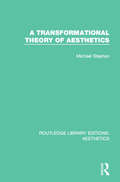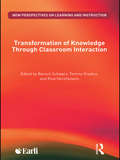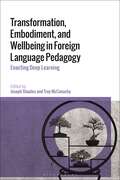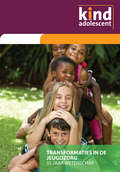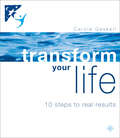- Table View
- List View
A Transformation Theory of Aesthetics
by Michael StephanThis book develops a theory of picture perception and aesthetic response, arguing that images can generate in us a complex pattern of mental changes, or transformations. It is essential reading to those seriously involved in linking the arts and cognitive sciences.
A Transformation Theory of Aesthetics
by Michael StephanThis book develops a theory of picture perception and aesthetic response, arguing that images can generate in us a complex pattern of mental changes, or transformations. It is essential reading to those seriously involved in linking the arts and cognitive sciences.
Transformation of the Psyche: The Symbolic Alchemy of the Splendor Solis
by Joseph L. Henderson Dyane N. SherwoodWritten by Joseph L. Henderson, one of the first generation of Jungian analysts, and Dyane N. Sherwood, a practising analyst, this book is a striking and unique contribution to the resurgence of interest in alchemy for its way of representing the phenomenology of creative experience. Transformation of the Psyche is organized around 22 illuminated paintings from the early Renaissance alchemical manuscript the Splendor Solis, and is further illustrated by over 50 colour figures. The images of the Splendor Solis are possibly the most beautiful and evocative alchemical paintings to be found anywhere, and they are widely known to students of alchemy. Jung reproduced several Splendor Solis images in his works, yet prior to this book no one has explored the symbolism of the paintings as a series in relation to the process of depth psychological transformation. This book is the first scholarly study of the paintings in their entirety, and of the mythological and historical allusions contained within the images. Transformation of the Psyche does not simply explain or analyze the pictures, but invites the reader to participate in the creative and transforming process evoked by these images.Transformation of the Psyche is a truly unique book that will be of immense value and interest to analysts and psychotherapists, as well as scholars of mediaeval and renaissance intellectual history and students of spiritual disciplines.
Transformation of the Psyche: The Symbolic Alchemy of the Splendor Solis
by Joseph L. Henderson Dyane N. SherwoodWritten by Joseph L. Henderson, one of the first generation of Jungian analysts, and Dyane N. Sherwood, a practising analyst, this book is a striking and unique contribution to the resurgence of interest in alchemy for its way of representing the phenomenology of creative experience. Transformation of the Psyche is organized around 22 illuminated paintings from the early Renaissance alchemical manuscript the Splendor Solis, and is further illustrated by over 50 colour figures. The images of the Splendor Solis are possibly the most beautiful and evocative alchemical paintings to be found anywhere, and they are widely known to students of alchemy. Jung reproduced several Splendor Solis images in his works, yet prior to this book no one has explored the symbolism of the paintings as a series in relation to the process of depth psychological transformation. This book is the first scholarly study of the paintings in their entirety, and of the mythological and historical allusions contained within the images. Transformation of the Psyche does not simply explain or analyze the pictures, but invites the reader to participate in the creative and transforming process evoked by these images.Transformation of the Psyche is a truly unique book that will be of immense value and interest to analysts and psychotherapists, as well as scholars of mediaeval and renaissance intellectual history and students of spiritual disciplines.
The Transformation of Sexuality: Gender and Identity in Contemporary Youth Culture
by Thomas JohanssonHow do contemporary young people construct their sexual identities? Are young people sexually liberated, or is human sexuality increasingly controlled and manipulated by commercial forces? Thomas Johansson explores the construction of sexual identities by young people as part of a wider process of identity construction, combining the work of key authors such as Elias and Foucault with original and revealing empirical material drawn from an extensive survey of the views of 1300 sixteen to nineteen year olds, combined with a number of qualitative in-depth interviews with different sexual subcultures. Topics covered include fidelity and infidelity, love, homosexuality, pornography and beauty ideals. Designed to look beyond media images and popular prejudices the book illustrates how young people of both genders, of different nationalities and of different group allegiances view and relate to their own sexuality.
The Transformation of Sexuality: Gender and Identity in Contemporary Youth Culture
by Thomas JohanssonHow do contemporary young people construct their sexual identities? Are young people sexually liberated, or is human sexuality increasingly controlled and manipulated by commercial forces? Thomas Johansson explores the construction of sexual identities by young people as part of a wider process of identity construction, combining the work of key authors such as Elias and Foucault with original and revealing empirical material drawn from an extensive survey of the views of 1300 sixteen to nineteen year olds, combined with a number of qualitative in-depth interviews with different sexual subcultures. Topics covered include fidelity and infidelity, love, homosexuality, pornography and beauty ideals. Designed to look beyond media images and popular prejudices the book illustrates how young people of both genders, of different nationalities and of different group allegiances view and relate to their own sexuality.
Transformation of Knowledge through Classroom Interaction (New Perspectives on Learning and Instruction)
by Baruch Schwarz Tommy Dreyfus Rina HershkowitzClassrooms provide extremely varied settings in which learning may take place, including teacher-led conversations, small group unguided discussions, individual problem solving or computer supported collaborative learning (CSCL). Transformation of Knowledge through Classroom Interaction examines and evaluates different ways which have been used to support students learning in classrooms, using mathematics and science as a model to examine how different types of interactions contribute to students’ participation in classroom activity, and their understanding of concepts and their practical applications. The contributions in this book offer rich descriptions and ways of understanding how learning occurs in both traditional and non-traditional settings. Combining theoretical perspectives with practical applications, the book includes discussions of: the roles of dialogue and argumentation in constructing knowledge the role of guidance in constructing knowledge abstracting processes in mathematics and science classrooms the effect of environment, media and technology on learning processes methodologies for tracing transformation of knowledge in classroom interaction. Bringing together a broad range of contributions from leading international researchers, this book makes an important contribution to the field of classroom learning, and will appeal to all those engaged in academic research in education.
Transformation of Knowledge through Classroom Interaction (New Perspectives on Learning and Instruction)
by Baruch Schwarz Tommy Dreyfus Rina HershkowitzClassrooms provide extremely varied settings in which learning may take place, including teacher-led conversations, small group unguided discussions, individual problem solving or computer supported collaborative learning (CSCL). Transformation of Knowledge through Classroom Interaction examines and evaluates different ways which have been used to support students learning in classrooms, using mathematics and science as a model to examine how different types of interactions contribute to students’ participation in classroom activity, and their understanding of concepts and their practical applications. The contributions in this book offer rich descriptions and ways of understanding how learning occurs in both traditional and non-traditional settings. Combining theoretical perspectives with practical applications, the book includes discussions of: the roles of dialogue and argumentation in constructing knowledge the role of guidance in constructing knowledge abstracting processes in mathematics and science classrooms the effect of environment, media and technology on learning processes methodologies for tracing transformation of knowledge in classroom interaction. Bringing together a broad range of contributions from leading international researchers, this book makes an important contribution to the field of classroom learning, and will appeal to all those engaged in academic research in education.
Transformation in Clinical and Developmental Psychology
by Deirdre A. Kramer and Michael J. BoppOne goal of this volume is to critically examine existing metatheory in psychology. Its second goal is to portray how particular psychological endeavors can be enhanced by the application of metatheories, alternatives to the traditional mechanistic outlook. The alternative conceptual frameworks explored in this volume, namely, contextualism and dialectics, assume a fluid and metaphorical view of change, growth, development, and transformation. The areas of clinical and developmental psychology are fields wich are primarily concerned with explaining and promoting change. This volume offers a fresh conceptual perspective on psychological change.
Transformation, Embodiment, and Wellbeing in Foreign Language Pedagogy: Enacting Deep Learning
by Joseph Shaules and Troy McConachyThis volume introduces pedagogical approaches and empirical studies that emphasize deeper, embodied engagement with language, the transformative potential of the language learning experience, and the importance of learner and teacher well-being. A deep learning orientation sees foreign language learning not as a psychologically neutral process of internalising linguistic rules but as an embodied process that is intimately tied to learners' experience of self, including emotion, body states, metaphoric understanding, aesthetic sensibilities, and moral intuitions. This volume challenges language teachers and teacher trainers to move beyond instrumentalist views of language learning, to recognise the deeply impactful nature of the language learning experience, and to consider how language pedagogy can contribute to the development of the learner as a whole person.Chapters in this volume consider the enactment of deep learning from diverse theoretical perspectives, including positive psychology, embodied cognition, cognitive linguistics, motivational theory, literary theory, and moral psychology. The volume provides language teachers, teacher trainers and applied linguists with concrete insights into the multidisciplinary foundations of conceptualizing, planning, and implementing deep learning in language classrooms.
Transformation, Embodiment, and Wellbeing in Foreign Language Pedagogy: Enacting Deep Learning
This volume introduces pedagogical approaches and empirical studies that emphasize deeper, embodied engagement with language, the transformative potential of the language learning experience, and the importance of learner and teacher well-being. A deep learning orientation sees foreign language learning not as a psychologically neutral process of internalising linguistic rules but as an embodied process that is intimately tied to learners' experience of self, including emotion, body states, metaphoric understanding, aesthetic sensibilities, and moral intuitions. This volume challenges language teachers and teacher trainers to move beyond instrumentalist views of language learning, to recognise the deeply impactful nature of the language learning experience, and to consider how language pedagogy can contribute to the development of the learner as a whole person.Chapters in this volume consider the enactment of deep learning from diverse theoretical perspectives, including positive psychology, embodied cognition, cognitive linguistics, motivational theory, literary theory, and moral psychology. The volume provides language teachers, teacher trainers and applied linguists with concrete insights into the multidisciplinary foundations of conceptualizing, planning, and implementing deep learning in language classrooms.
Transformation: Jung's Legacy and Clinical Work Today
by Alessandra CavalliThis book offers a challenging reading of the legacy of C.G. Jung, who offered fascinating insights into the psyche. It is intended for clinicians of different schools who are interested in a deeper understanding of the relationship between patient and analyst.
Transformation: Jung's Legacy and Clinical Work Today
by Alessandra Cavalli Lucinda Hawkins Martha StevnsThis book offers a challenging reading of the legacy of C.G. Jung, who offered fascinating insights into the psyche. It is intended for clinicians of different schools who are interested in a deeper understanding of the relationship between patient and analyst.
Transformaties in de jeugdzorg: 35 jaar wetenschap
by Sander Begeer Leonieke Boendermaker Hilde Colpin Marca Geeraets Helma Koomen Nanda Lambregts-Rommelse Karla Van Leeuwen Ramon Lindauer Geertjan Overbeek Peter Prinzie Gerda Smid Bart Soenens Gonneke StevensHet boek bestaat uit een verzameling van 9 artikelen, eerder verschenen in het themanummer van Kind en Adolescent in 2015, die vanuit verschillend perspectief 35 jaar wetenschappelijk onderzoek behandelen die relevant is voor de pedagogische, psychiatrische en psychologische praktijk. Wat weten we nu eigenlijk over de effecten van bepaalde behandelingen, waarom worden effectief bewezen behandelingen niet meer ingezet, hoe kunnen foutieve ideeen hierover weerlegt worden en vervangen door nieuwe kennis? Het boek geeft antwoord op hoe het denken van professionals in de kinder- en jeugdpsychiatrie is veranderd, getransformeerd door wat wetenschappelijk onderzoek de afgelopen 35 jaar heeft opgeleverd. En ook wat de implicaties hiervan zijn voor het handelen in de klinische praktijk. De insteek is breed omdat vanuit meerdere perspectieven naar de (bedreigde) ontwikkeling van kinderen gekeken kan worden. Vanuit de invloed van de school, de rol van de ouders, maar ook vanuit neurobiologische factoren.
Transform Your Life: 10 Steps To Real Results
by Carole GaskellAn inspirational step-by-step guide to Taking Charge of Your Life and Unlocking Your Full Potential. Due to the level of detail, quizzes and illustrations are best viewed on a tablet.
Transferences: The Aesthetics and Poetics of the Therapeutic Relationship (Psychoanalytic Horizons)
by Maren ScheurerWhy are psychoanalysts fascinated with literature and other arts? And why do so many novels, plays, films, and television series feature therapy sessions? Transferences investigates the interdisciplinary attraction between psychoanalysis and the arts by exploring the therapeutic relationship as a recurring figure in psychoanalytic discourse, literature, theater, and television. In addition to close readings of psychoanalytic and critical texts, the book presents a new approach to examining psychoanalytic themes and formal devices in texts like Philip Roth's Portnoy's Complaint, J. M. Coetzee's Life & Times of Michael K, Margaret Atwood's Alias Grace, Peter Shaffer's Equus, and the HBO series In Treatment.Transferences argues that psychoanalysts as well as writers and other artists are fascinated by the therapeutic relationship because it provides a unique site to negotiate the narrative and artistic underpinnings of psychoanalysis and reflect and reinvent the aesthetic and poetic potentiality of art.
Transferences: The Aesthetics and Poetics of the Therapeutic Relationship (Psychoanalytic Horizons)
by Maren ScheurerWhy are psychoanalysts fascinated with literature and other arts? And why do so many novels, plays, films, and television series feature therapy sessions? Transferences investigates the interdisciplinary attraction between psychoanalysis and the arts by exploring the therapeutic relationship as a recurring figure in psychoanalytic discourse, literature, theater, and television. In addition to close readings of psychoanalytic and critical texts, the book presents a new approach to examining psychoanalytic themes and formal devices in texts like Philip Roth's Portnoy's Complaint, J. M. Coetzee's Life & Times of Michael K, Margaret Atwood's Alias Grace, Peter Shaffer's Equus, and the HBO series In Treatment.Transferences argues that psychoanalysts as well as writers and other artists are fascinated by the therapeutic relationship because it provides a unique site to negotiate the narrative and artistic underpinnings of psychoanalysis and reflect and reinvent the aesthetic and poetic potentiality of art.
Transference, Love, Being: Essential Essays from the Field
by Andrea CelenzaThrough a series of expansive essays, Transference, Love, Being explores the centrality of love in psychoanalytic practice. Starting with the immersion of the analyst, this book reimagines several aspects of the psychoanalytic process, including transference, countertransference, boundaries, embodiment, subjectivity and eroticism. To love is to cultivate to be. Psychoanalysis, as essentially vitalizing, is a playspace for taboo subjects within clear and safe parameters. Interweaving loving, being and perceiving, this book provides challenging new perspectives on the analysts's subjectivity, receptivity and its immersive influence on the analytic process. These essays refine theoretical understandings of the irreducible and omnipresent nature of love in psychoanalysis, thereby offering clarity to psychoanalysts, psychodyanmic therapists and scholars through the often-prohibited love and eroticism, here viewed as indispensible psychoanalytic theory and practice.
Transference, Love, Being: Essential Essays from the Field
by Andrea CelenzaThrough a series of expansive essays, Transference, Love, Being explores the centrality of love in psychoanalytic practice. Starting with the immersion of the analyst, this book reimagines several aspects of the psychoanalytic process, including transference, countertransference, boundaries, embodiment, subjectivity and eroticism. To love is to cultivate to be. Psychoanalysis, as essentially vitalizing, is a playspace for taboo subjects within clear and safe parameters. Interweaving loving, being and perceiving, this book provides challenging new perspectives on the analysts's subjectivity, receptivity and its immersive influence on the analytic process. These essays refine theoretical understandings of the irreducible and omnipresent nature of love in psychoanalysis, thereby offering clarity to psychoanalysts, psychodyanmic therapists and scholars through the often-prohibited love and eroticism, here viewed as indispensible psychoanalytic theory and practice.
Transference in Institutional Work with Psychosis and Autism: The Transferential Constellation (Routledge Focus on Mental Health)
by Pierre DelionTransference in Institutional Work with Psychosis and Autism presents Pierre Delion’s extensive experience in psychiatric institutions, focusing on the concept of the transferential constellation. Delion first discusses the pioneering work of François Tosquelles at the Saint Alban psychiatric hospital, which enabled psychoanalytic treatment to be applied in cases of severe psychopathologies. The book then explains how the transferential constellation can provide a deeper and more effective understanding of a patient’s needs by engaging all caregivers within an organisation over the course of the patient’s treatment history. Delion describes how regular meetings of all the team participants allow them to express different and even divergent views of the patient and to appreciate their complementary contributions to the institution. The transferential constellation is presented as an important development in the history of patient-centered psychiatric care and a touchstone for its ongoing humanistic development. Transference in Institutional Work with Psychosis and Autism will be of great interest to psychiatrists and psychotherapists in practice and in training. It will also be key reading for other practitioners and caregivers working in mental health institutions.
Transference in Institutional Work with Psychosis and Autism: The Transferential Constellation (Routledge Focus on Mental Health)
by Pierre DelionTransference in Institutional Work with Psychosis and Autism presents Pierre Delion’s extensive experience in psychiatric institutions, focusing on the concept of the transferential constellation. Delion first discusses the pioneering work of François Tosquelles at the Saint Alban psychiatric hospital, which enabled psychoanalytic treatment to be applied in cases of severe psychopathologies. The book then explains how the transferential constellation can provide a deeper and more effective understanding of a patient’s needs by engaging all caregivers within an organisation over the course of the patient’s treatment history. Delion describes how regular meetings of all the team participants allow them to express different and even divergent views of the patient and to appreciate their complementary contributions to the institution. The transferential constellation is presented as an important development in the history of patient-centered psychiatric care and a touchstone for its ongoing humanistic development. Transference in Institutional Work with Psychosis and Autism will be of great interest to psychiatrists and psychotherapists in practice and in training. It will also be key reading for other practitioners and caregivers working in mental health institutions.
Transference And Projection
by Jan Grant Jim CrawleyThis book describes, defines and demonstrates the clinical applications of transference and projection and how they are used by psychotherapists as 'mirrors to the self' - as reflections of a client's internal structure and core ways of relating to other people. There is an emphasis on understanding transference as a normal organizing process that helps individuals make sense of interpersonal experiences. There is also a focus on how to respond effectively to transference and projection in the day-to-day practice of counselling and psychotherapy. Comprehensive coverage of the ways in which the major schools of psychotherapy understand and utilize such phenomena is also provided. Theoretical principles are illustrated by lively clinical anecdotes from the authors' own psychotherapy practices.Transference and Projection is aimed at advanced undergraduate and postgraduate students of psychotherapy, counselling, counselling psychology and clinical psychology. It will also be of interest to therapy students in professional training courses and experienced clinicians who want to know more about this aspect of psychotherapy.
Transference and Empathy in Asian American Psychotherapy: Cultural Values and Treatment Needs
by Jean Lau Chin Joan Huser Liem MaryAnna Domokos-Cheng Ham George K. HongThe Asian American population is increasing rapidly and, not unpredictably, so are its mental health needs. A number of cultural factors and stressors common to Asian Americans pose obstacles to the successful employment of Western psychotherapy approaches and counseling---for example, the central role of the family in Asian life and the culturally based, traditional stigma associated with mental health problems. The authors, all practicing psychotherapists, focus on the critical aspects of transference and empathy in their consideration of the mental health approaches and therapies appropriate to ethnic minority population.The work has value as a resource for professionals and as a training guide for those intending to practice as psychotherapists and counselors in minority communities. It offers extraordinary insights and practical guidance through the use of case studies. Not only do these identify problems stemming from the racial differences between client and therapist, but they also provide rich clinical examples of case diagnosis, treatment plans, and client status statements. This is an important book that will further both the theory and practice of psychotherapy among minority populations.
Transference and Countertransference Today (The New Library of Psychoanalysis)
by Robert OelsnerWhy has Heinrich Racker’s original work on transference and countertransference proven so valuable? With a passionate concern for the field created by the meeting of analyst and patient, and an abiding interest in the central importance of transference and countertransference in analytic practice, Robert Oelsner has brought together the thought and work of seventeen eminent analysts from Europe, the United States, and Latin America. In new essays commissioned for this volume, the writers have set aside the lines that can often divide psychoanalytic groups and schools in order to examine in depth the variety of approaches and responses that characterize the best analytic practice today. The result is a collection of fresh, contemporary material centred on the two interrelated subjects – transference and countertransference – that make up the core of psychoanalytic work. Both in the clarity of their language and in moving clinical examples the writers reveal, in distinctively personal ways, how Heinrich Racker’s original thought, which brought the analyst’s unconscious responses into the equation, has allowed them to evolve their own perspectives. Yet it is particularly interesting to find unexpected parallels among the chapters that point toward a shared vision. Clearly, whether in work with adults or children, transference and countertransference are now seen as encompassing a field that embraces both participants in the consulting room. Making Transference and Countertransference Today still more valuable as a resource for teachers and students are several major contributions by authors whose work is not otherwise readily available in English. Psychoanalysts and others will find few other books that present such a thoughtful picture of these crucial and fascinating analytic topics.
Transference and Countertransference Today (The New Library of Psychoanalysis)
by Robert OelsnerWhy has Heinrich Racker’s original work on transference and countertransference proven so valuable? With a passionate concern for the field created by the meeting of analyst and patient, and an abiding interest in the central importance of transference and countertransference in analytic practice, Robert Oelsner has brought together the thought and work of seventeen eminent analysts from Europe, the United States, and Latin America. In new essays commissioned for this volume, the writers have set aside the lines that can often divide psychoanalytic groups and schools in order to examine in depth the variety of approaches and responses that characterize the best analytic practice today. The result is a collection of fresh, contemporary material centred on the two interrelated subjects – transference and countertransference – that make up the core of psychoanalytic work. Both in the clarity of their language and in moving clinical examples the writers reveal, in distinctively personal ways, how Heinrich Racker’s original thought, which brought the analyst’s unconscious responses into the equation, has allowed them to evolve their own perspectives. Yet it is particularly interesting to find unexpected parallels among the chapters that point toward a shared vision. Clearly, whether in work with adults or children, transference and countertransference are now seen as encompassing a field that embraces both participants in the consulting room. Making Transference and Countertransference Today still more valuable as a resource for teachers and students are several major contributions by authors whose work is not otherwise readily available in English. Psychoanalysts and others will find few other books that present such a thoughtful picture of these crucial and fascinating analytic topics.
